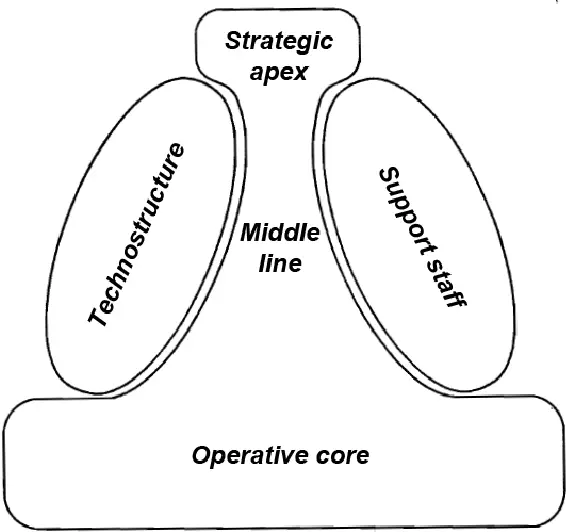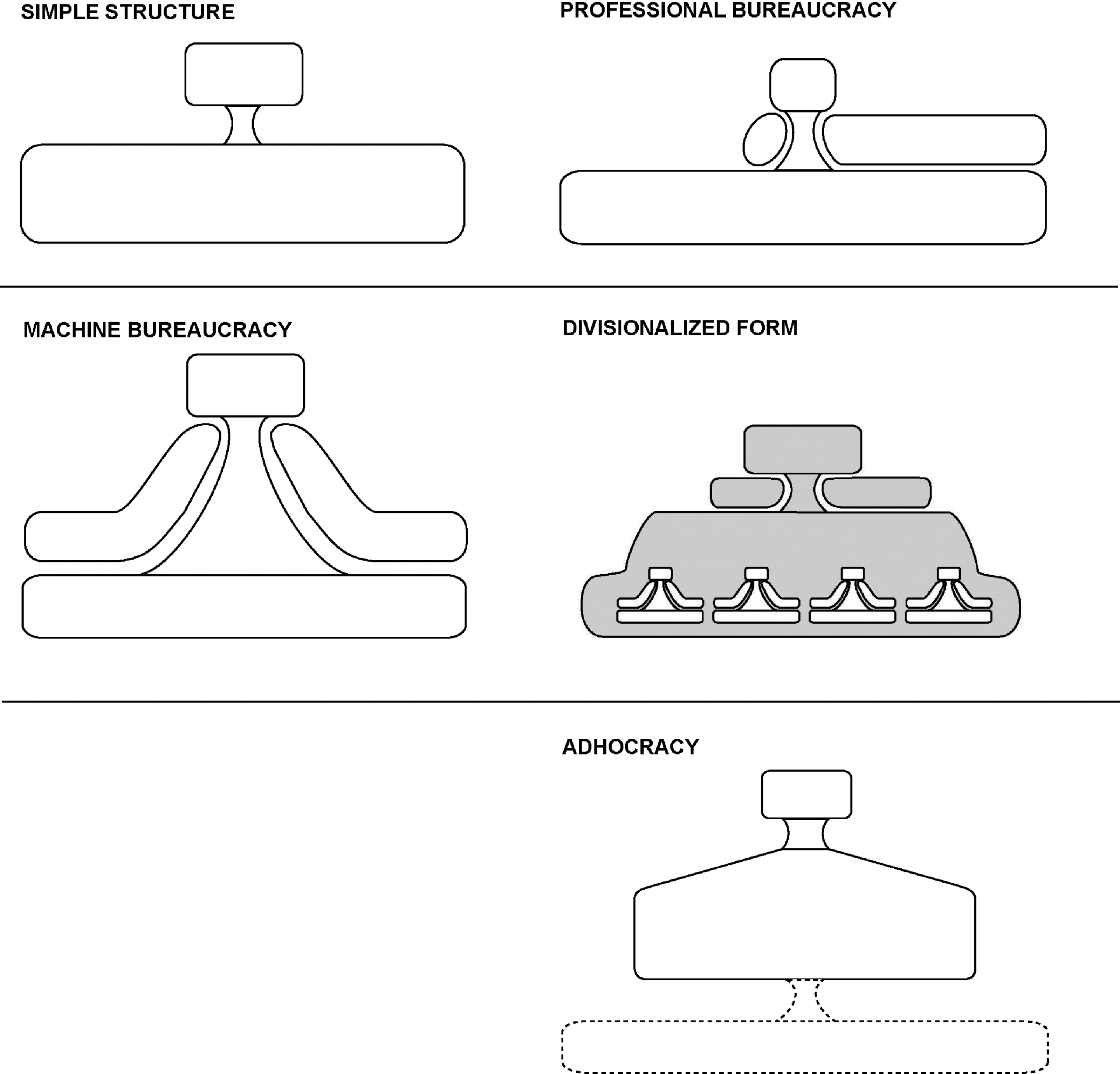Henry Mintzberg Organizational Structure | Mintzberg 5 Parts of an Organization
What is Organizational Structure?
An organizational structure is a framework outlining how specific activities flow within an organization. An organizational structure defines how activities are directed toward the achievement of the organization. These activities include; task allocation, roles coordination, supervision, rules, and responsibilities.
Mintzberg 5 Parts of an Organization
In 1979 Henry Mintzberg, in his book The Structuring of Organizations, developed an organizational structure model that showed what he called the five basic parts of the organization. These five parts include;
- Strategic Apex; Who are the senior level of management
- Middle line; Who are the middle management
- Operating core; Who are the workers of the organization
- Support staff; Who are the admin support and indirect services
- Techno structure; Who are the analysts who plan and control the work of others
 In
In
In the model is the top of the organization, which Henry Mintzberg called the strategic apex. We have the middle line supported by the support staff and the technostructure, and at the lower end of the organization, the is the operating core.
Operating Core of an Organization
Mintzberg’s Operating core is that’s the basic work of producing the organization’s products and services get done here.
Strategic Apex of an Organization
Mintzberg’s Strategic Apex is the home of top management and senior management who decided the organization’s strategic direction.
The Middle Line
Mintzberg’s middle line is where managers stand in a direct line relationship between the strategic apex and the operating core or middle management.
Technostructure Mintzberg
Mintzberg technostructure are the staff analysts who designed the systems by which work processes and outputs are standardized in the organization.
Support Staff
Mintzberg support staff are specialists who provide support to the organization outside of its operating workflow.
These are the five basic parts of the organization that Mintzberg identified.
Henry Mintzberg Organizational Structures
Five Organizational Structures.
These include
- Simple organizational Structure
- The Machine Bureaucracy Structure
- The Professional Bureaucracy Structure
- The Divisionalized Form Structure
- Adhocracy Organizational Structure
Mintzberg Simple Structure
In Mintzberg Simple Structure, the strategic apex is the top management charged with ensuring that the organization serves its mission effectively. Here top management make the strategic decisions for the organization and feed this information down to the middle line, who are the middle managers,
Middle managers and delegate these decisions down the chain of command to the operating core; who are the workers?
Those that perform the basic work-related directly to the production of products and services.
This form is fine for simple structures. It is fast, flexible, and lean, but as an organization grows, this structure may become inadequate as decision-makers can become so overwhelmed that they start to make incorrect decisions.
This is when they need to start sharing power and decision-making.
In Mintzberg’s diagram of the simple structure, you could see the strategic apex directly linked to the operating core.
There’s very little evidence of any middle line in this structure and very little evidence of any technostructure and support staff.
The strategic apex provides directs supervision; it provides vertical and horizontal centralization.
This is a simple and dynamic model, and sometimes it can be hostile.
Simple Organizational Structure Examples
Simple organization structures best suit perhaps an entrepreneurial firm where you have a leadership team, and then you have people who are operating at the core of the organization delivering goods.
Machine Bureaucracy Structure
Take mass production organizations, for example. They would employ a large number of employees and therefore would require more specialist support staff on technostructure. This structure is known as the machine bureaucracy.
The organization still has a strategic apex, middle line, and operating core as before, but it also has support staff. Support Staff will be the likes of accounting, information technology, and human resources.
They’re the specialized unit that exists to provide support to the organization outside the operating workflow.
Techno structures are the analysts who served the organization by affecting the work of others. This may be through designing training procedures and making sure an organization follows proper legal rules and procedures.
With machines, bureaucracy work is very formalized. There are many routines and procedures.
Decision-making is centralized, and functional departments group tasks. Work is clearly defined using formal planning processes, budgets and audits on procedures are regularly checked for efficiency.
It has a strategic apex, we have the emergence of what Mintzberg called the middle line, and here we have the emergence of some support staff and some technostructure and operating core. The technostructure, these guys are looking to standardize work processes.
Machine Bureaucracy examples
This is a simple and stable model, and again it suits companies like mass production firms, service firms with simple, repetitive work.
Professional Bureaucracy Form of Structure
The next type of model Mintzberg identified was what he called a professional bureaucracy. It has quite a lot of support staff, not a lot of technol staff.
Has a strategic apex, a small amount of middle line, and quite a substantial operating core.
The professional bureaucracy where machine bureaucracy is standardized, such as mass production, government agencies, professional bureaucracy refers to firms where each job is different on professional expertise is required, for example, lawyer and accountancy firms.
Each client’s experience will be unique. The organization is decentralized on realizing and highly trained individuals who demand control of their own workload.
We have standardization of skills and vertical and horizontal decentralization. This can give rise to a complex, stable organization.
Professional Bureaucracy Company Examples
Organizations with this type of format include schools, social work agencies, and perhaps accounting firms.
Divisionalized Form Mintzberg
Divisionalized form may be used by large corporations that have different business units and product lines. A central headquarters supports a number of independent divisions.
This type of structure is often found in large, well-established organizations that have a variety of brands.
There are independent entities and all encompassed in one overarching division allies structure, which has a significant amount of support staff, a little bit of technostructure, and a strategic apex.
It has a middle line with limited vertical decentralization but standardization and is relatively simple and stable, and it helps us to compete in diverse marketplaces.
Divisionalized Form Examples
Divisionalized Form suits large corporations and large multinational corporations. It also suits governments where each government department is specialized in its own way and has its own strategic apex support staff, techno staff, middle line, and operating core.
But all of those individual departments then refer into an overall government structure, which in turn has further support infrastructure and a little bit of technostructure.
Adhocracy Organizational Structure
Adhocracy Organizational Structure is common in new industries or companies that want to become innovative leaders. Innovative organizations higher and give power to experts.
Decentralized decision making is the key here.
Innovative organizations are suitable for project-based industries where there is a need to innovate and function on an ad hoc basis to survive.
And again, what this is that we’ve got some support staff, and we have mutual adjustment and selective vertical and horizontal decentralization.
This model is supporting a complex and dynamic type of business. But then they have enough variability in their structure to be able to contract significantly after the contract has been delivered.
Adhocracy Organizational Structure Examples
Filmmaking is an excellent example of an innovative organization. Others include consulting firms, advertising agencies, chemical firms, and space agencies to grow significantly when a new contract is awarded.

Conclusion
Mintzberg said that the organization structure represents the organization’s effort to align its internal processes with its external environment while balancing a range of structural dilemmas.
Mintzberg said that structural configurations aligned with different tasks in different environments, and, again, changes in this environment pressure organizations to realign their structure.
Generic Issues In Restructuring
When restructuring the organization, there are some generic issues with respect to the Mintzberg model in restructuring.
- The strategic apex is pushing for alignment and centralization.
- In contrast to this, middle managers in restructuring try to protect their own autonomy and the own room to run their own business unit.
- In times of restructuring, the technostructure pushes for standardization, and it believes in measurement and monitoring and strict process.
- The support staff, on the other hand, prefer less hierarchy on more collaboration.





